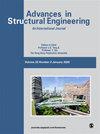Gyroscopic rotor dynamics simulation with anisotropy of elastic and damping characteristics of the support
IF 2
4区 工程技术
引用次数: 0
Abstract
In the work, the differential equations of motion of the gyroscopic rotor, built taking into account the anisotropy of stiffness and damping of the flexible support, are solved analytically, by the method of harmonic balance, convenient for obtaining separately amplitude-frequency and phase-frequency characteristics in the direction of oscillations. The equations of the non-stationary process are obtained by the method of changing amplitudes. It has been found that when the linear stiffness of the elastic support is different in two orthogonal directions, two critical velocities and the corresponding resonant regions arise. In the area of each critical speed, there are two amplitude-frequency curves of oscillations of the main direction and the direction perpendicular to it, respectively. The geometric nonlinearity of damping suppresses the elevations of these amplitude-frequency curves more significantly than linear damping. If only one of the two directions has a damping nonlinearity, then its effect is on the amplitude-frequency curves of the corresponding critical speed. It is more efficient to control resonant amplitudes for smooth resonant transitions by enhancing the linear damping with geometrically nonlinear damping. The results of the analytical solution of the equations of motion agree well with the results of direct modeling and experimental studies.具有支撑物弹性和阻尼特性各向异性的陀螺转子动力学模拟
在这项工作中,陀螺转子的运动微分方程是在考虑到柔性支座的刚度和阻尼各向异性的情况下建立的,采用谐波平衡法进行分析求解,这种方法便于分别获得振荡方向上的幅频特性和相频特性。非稳态过程的方程是通过改变振幅的方法得到的。研究发现,当弹性支撑的线性刚度在两个正交方向上不同时,会出现两个临界速度和相应的共振区。在每个临界速度区域内,分别存在主方向和与其垂直方向的两条振荡幅频曲线。阻尼的几何非线性比线性阻尼更能抑制这些幅频曲线的上升。如果两个方向中只有一个方向具有阻尼非线性,那么它对相应临界速度的幅频曲线产生影响。用几何非线性阻尼增强线性阻尼,能更有效地控制共振振幅,实现平稳的共振转换。运动方程的分析求解结果与直接建模和实验研究结果非常吻合。
本文章由计算机程序翻译,如有差异,请以英文原文为准。
求助全文
约1分钟内获得全文
求助全文
来源期刊

Advances in Mechanical Engineering
Engineering-Mechanical Engineering
自引率
4.80%
发文量
353
期刊介绍:
Advances in Mechanical Engineering (AIME) is a JCR Ranked, peer-reviewed, open access journal which publishes a wide range of original research and review articles. The journal Editorial Board welcomes manuscripts in both fundamental and applied research areas, and encourages submissions which contribute novel and innovative insights to the field of mechanical engineering
 求助内容:
求助内容: 应助结果提醒方式:
应助结果提醒方式:


